American History Homework: Chapters 19-26 Analysis & Review
VerifiedAdded on 2022/11/10
|8
|2066
|139
Homework Assignment
AI Summary
This assignment provides a comprehensive review of American History from 1900 to 1945, covering key periods such as Progressivism, World War I, World War II, and the Great Depression. The analysis begins with an overview of Progressivism, highlighting its social, political, and economic aspects, along with the impact of industrialization and cultural shifts. The assignment then explores the causes and consequences of WWI, including America's involvement and the impact of the war on domestic policies. It further examines the aftermath of WWI, including the rise of the Ku Klux Klan and the cultural changes of the 1920s, such as the Jazz Age and the impact of new technologies. The analysis also delves into the Great Depression, examining President Hoover's response, the New Deal policies implemented by President Roosevelt, and the impact of the Dust Bowl. Finally, the assignment assesses the relevance of Progressivism in the 20th century, discussing the challenges faced by the movement and its lasting impact on American society. The assignment concludes with a discussion on the role of modern-day Democratic politicians who call themselves progressives.
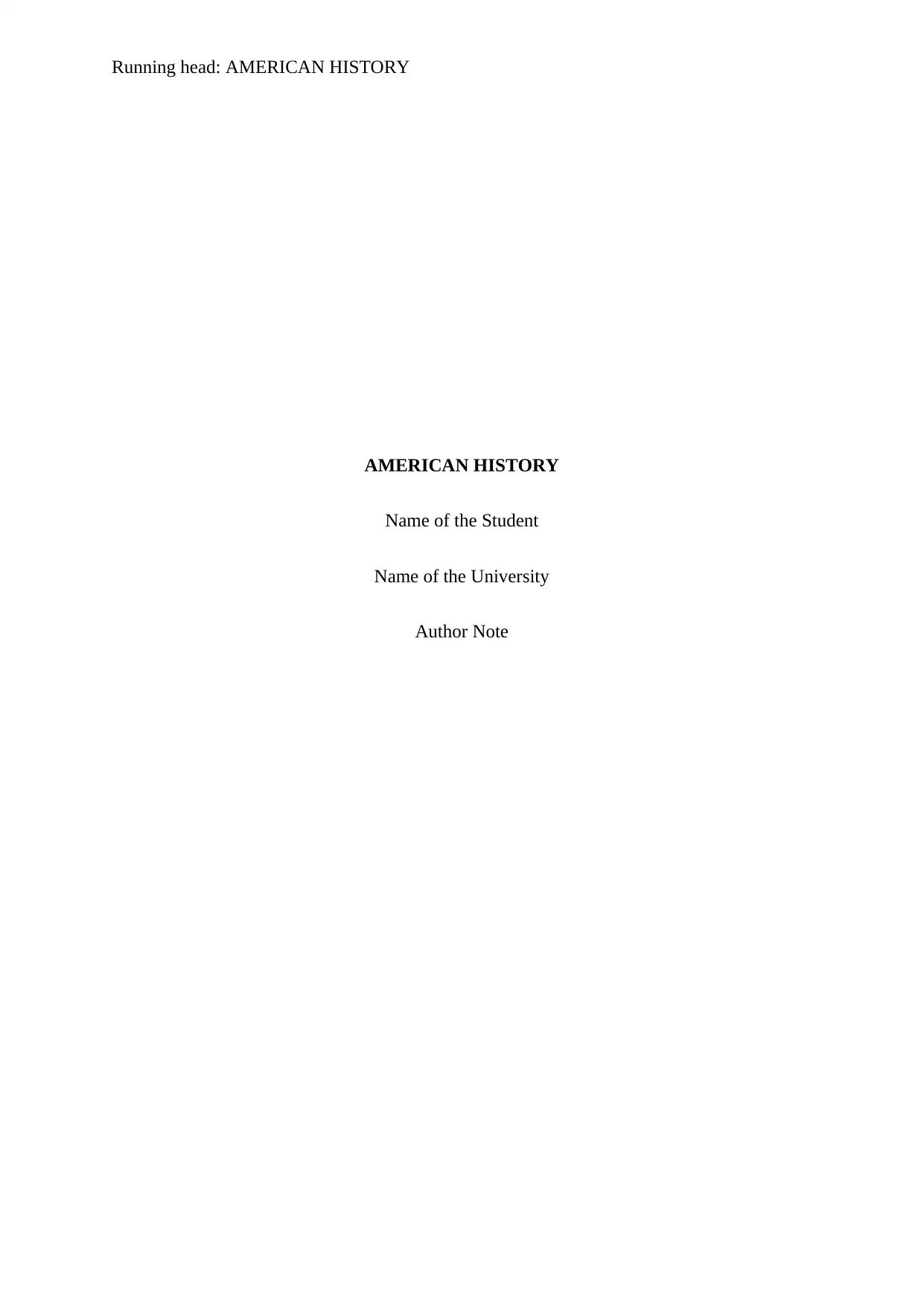
Running head: AMERICAN HISTORY
AMERICAN HISTORY
Name of the Student
Name of the University
Author Note
AMERICAN HISTORY
Name of the Student
Name of the University
Author Note
Paraphrase This Document
Need a fresh take? Get an instant paraphrase of this document with our AI Paraphraser
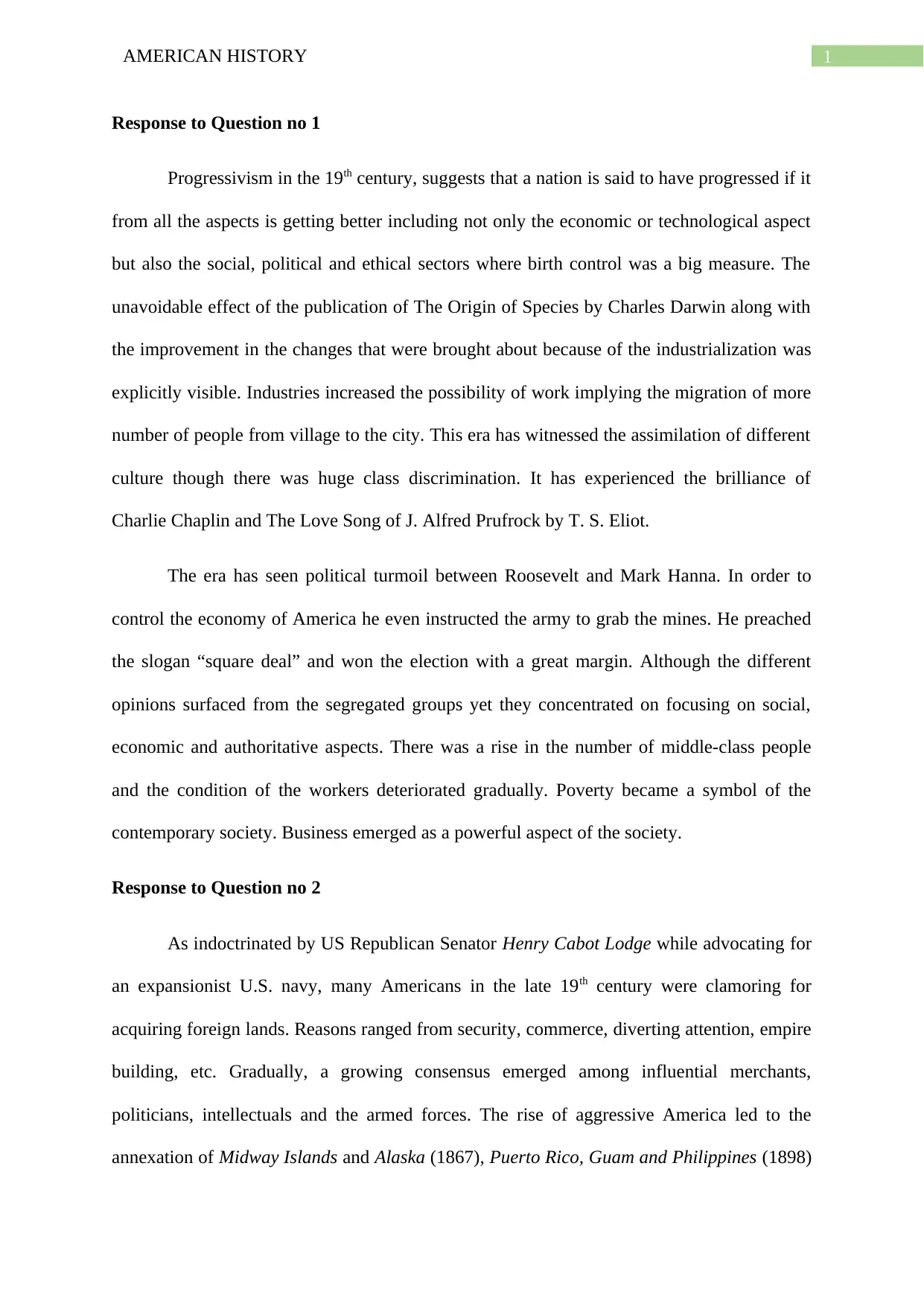
1AMERICAN HISTORY
Response to Question no 1
Progressivism in the 19th century, suggests that a nation is said to have progressed if it
from all the aspects is getting better including not only the economic or technological aspect
but also the social, political and ethical sectors where birth control was a big measure. The
unavoidable effect of the publication of The Origin of Species by Charles Darwin along with
the improvement in the changes that were brought about because of the industrialization was
explicitly visible. Industries increased the possibility of work implying the migration of more
number of people from village to the city. This era has witnessed the assimilation of different
culture though there was huge class discrimination. It has experienced the brilliance of
Charlie Chaplin and The Love Song of J. Alfred Prufrock by T. S. Eliot.
The era has seen political turmoil between Roosevelt and Mark Hanna. In order to
control the economy of America he even instructed the army to grab the mines. He preached
the slogan “square deal” and won the election with a great margin. Although the different
opinions surfaced from the segregated groups yet they concentrated on focusing on social,
economic and authoritative aspects. There was a rise in the number of middle-class people
and the condition of the workers deteriorated gradually. Poverty became a symbol of the
contemporary society. Business emerged as a powerful aspect of the society.
Response to Question no 2
As indoctrinated by US Republican Senator Henry Cabot Lodge while advocating for
an expansionist U.S. navy, many Americans in the late 19th century were clamoring for
acquiring foreign lands. Reasons ranged from security, commerce, diverting attention, empire
building, etc. Gradually, a growing consensus emerged among influential merchants,
politicians, intellectuals and the armed forces. The rise of aggressive America led to the
annexation of Midway Islands and Alaska (1867), Puerto Rico, Guam and Philippines (1898)
Response to Question no 1
Progressivism in the 19th century, suggests that a nation is said to have progressed if it
from all the aspects is getting better including not only the economic or technological aspect
but also the social, political and ethical sectors where birth control was a big measure. The
unavoidable effect of the publication of The Origin of Species by Charles Darwin along with
the improvement in the changes that were brought about because of the industrialization was
explicitly visible. Industries increased the possibility of work implying the migration of more
number of people from village to the city. This era has witnessed the assimilation of different
culture though there was huge class discrimination. It has experienced the brilliance of
Charlie Chaplin and The Love Song of J. Alfred Prufrock by T. S. Eliot.
The era has seen political turmoil between Roosevelt and Mark Hanna. In order to
control the economy of America he even instructed the army to grab the mines. He preached
the slogan “square deal” and won the election with a great margin. Although the different
opinions surfaced from the segregated groups yet they concentrated on focusing on social,
economic and authoritative aspects. There was a rise in the number of middle-class people
and the condition of the workers deteriorated gradually. Poverty became a symbol of the
contemporary society. Business emerged as a powerful aspect of the society.
Response to Question no 2
As indoctrinated by US Republican Senator Henry Cabot Lodge while advocating for
an expansionist U.S. navy, many Americans in the late 19th century were clamoring for
acquiring foreign lands. Reasons ranged from security, commerce, diverting attention, empire
building, etc. Gradually, a growing consensus emerged among influential merchants,
politicians, intellectuals and the armed forces. The rise of aggressive America led to the
annexation of Midway Islands and Alaska (1867), Puerto Rico, Guam and Philippines (1898)
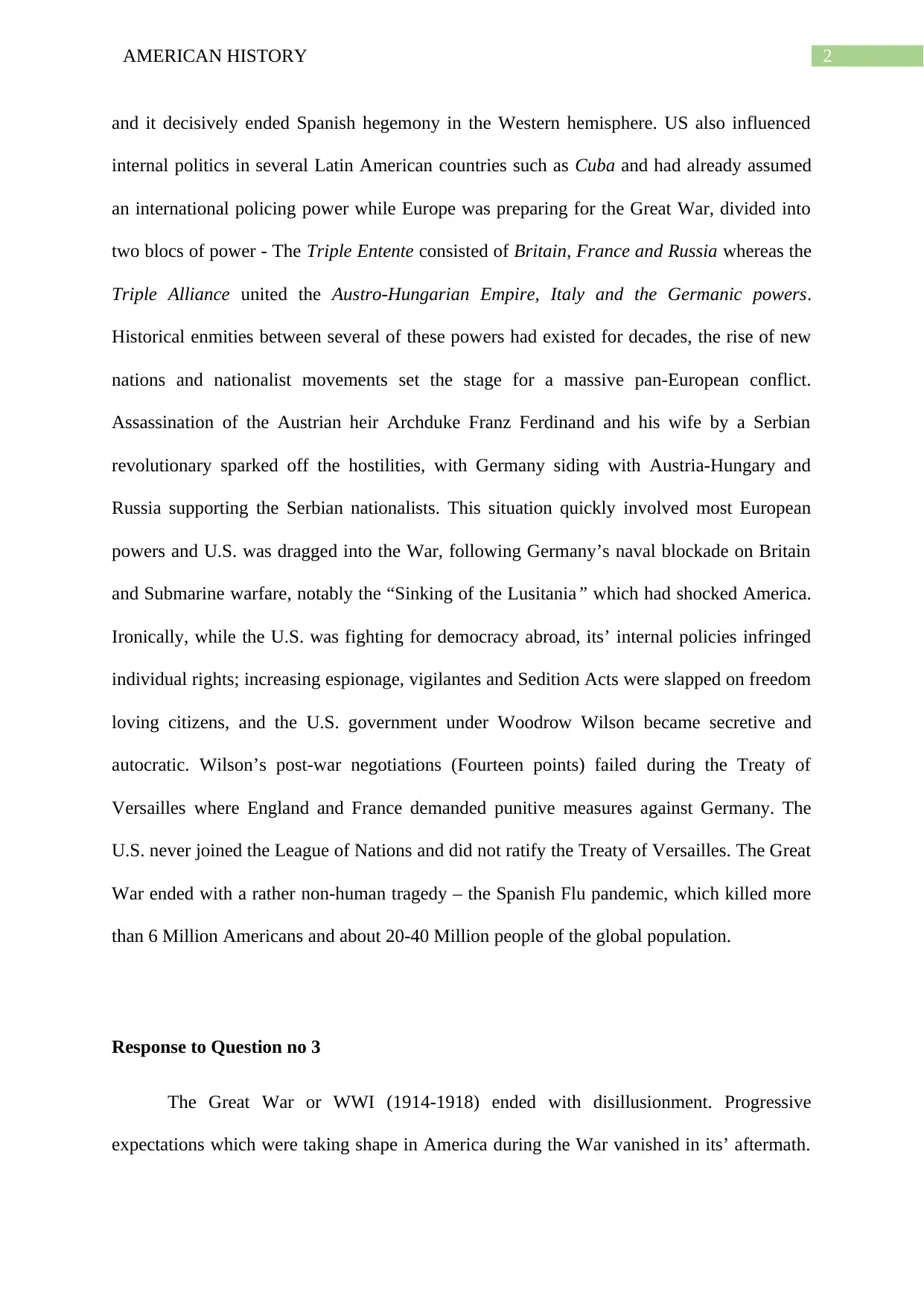
2AMERICAN HISTORY
and it decisively ended Spanish hegemony in the Western hemisphere. US also influenced
internal politics in several Latin American countries such as Cuba and had already assumed
an international policing power while Europe was preparing for the Great War, divided into
two blocs of power - The Triple Entente consisted of Britain, France and Russia whereas the
Triple Alliance united the Austro-Hungarian Empire, Italy and the Germanic powers.
Historical enmities between several of these powers had existed for decades, the rise of new
nations and nationalist movements set the stage for a massive pan-European conflict.
Assassination of the Austrian heir Archduke Franz Ferdinand and his wife by a Serbian
revolutionary sparked off the hostilities, with Germany siding with Austria-Hungary and
Russia supporting the Serbian nationalists. This situation quickly involved most European
powers and U.S. was dragged into the War, following Germany’s naval blockade on Britain
and Submarine warfare, notably the “Sinking of the Lusitania” which had shocked America.
Ironically, while the U.S. was fighting for democracy abroad, its’ internal policies infringed
individual rights; increasing espionage, vigilantes and Sedition Acts were slapped on freedom
loving citizens, and the U.S. government under Woodrow Wilson became secretive and
autocratic. Wilson’s post-war negotiations (Fourteen points) failed during the Treaty of
Versailles where England and France demanded punitive measures against Germany. The
U.S. never joined the League of Nations and did not ratify the Treaty of Versailles. The Great
War ended with a rather non-human tragedy – the Spanish Flu pandemic, which killed more
than 6 Million Americans and about 20-40 Million people of the global population.
Response to Question no 3
The Great War or WWI (1914-1918) ended with disillusionment. Progressive
expectations which were taking shape in America during the War vanished in its’ aftermath.
and it decisively ended Spanish hegemony in the Western hemisphere. US also influenced
internal politics in several Latin American countries such as Cuba and had already assumed
an international policing power while Europe was preparing for the Great War, divided into
two blocs of power - The Triple Entente consisted of Britain, France and Russia whereas the
Triple Alliance united the Austro-Hungarian Empire, Italy and the Germanic powers.
Historical enmities between several of these powers had existed for decades, the rise of new
nations and nationalist movements set the stage for a massive pan-European conflict.
Assassination of the Austrian heir Archduke Franz Ferdinand and his wife by a Serbian
revolutionary sparked off the hostilities, with Germany siding with Austria-Hungary and
Russia supporting the Serbian nationalists. This situation quickly involved most European
powers and U.S. was dragged into the War, following Germany’s naval blockade on Britain
and Submarine warfare, notably the “Sinking of the Lusitania” which had shocked America.
Ironically, while the U.S. was fighting for democracy abroad, its’ internal policies infringed
individual rights; increasing espionage, vigilantes and Sedition Acts were slapped on freedom
loving citizens, and the U.S. government under Woodrow Wilson became secretive and
autocratic. Wilson’s post-war negotiations (Fourteen points) failed during the Treaty of
Versailles where England and France demanded punitive measures against Germany. The
U.S. never joined the League of Nations and did not ratify the Treaty of Versailles. The Great
War ended with a rather non-human tragedy – the Spanish Flu pandemic, which killed more
than 6 Million Americans and about 20-40 Million people of the global population.
Response to Question no 3
The Great War or WWI (1914-1918) ended with disillusionment. Progressive
expectations which were taking shape in America during the War vanished in its’ aftermath.
⊘ This is a preview!⊘
Do you want full access?
Subscribe today to unlock all pages.

Trusted by 1+ million students worldwide
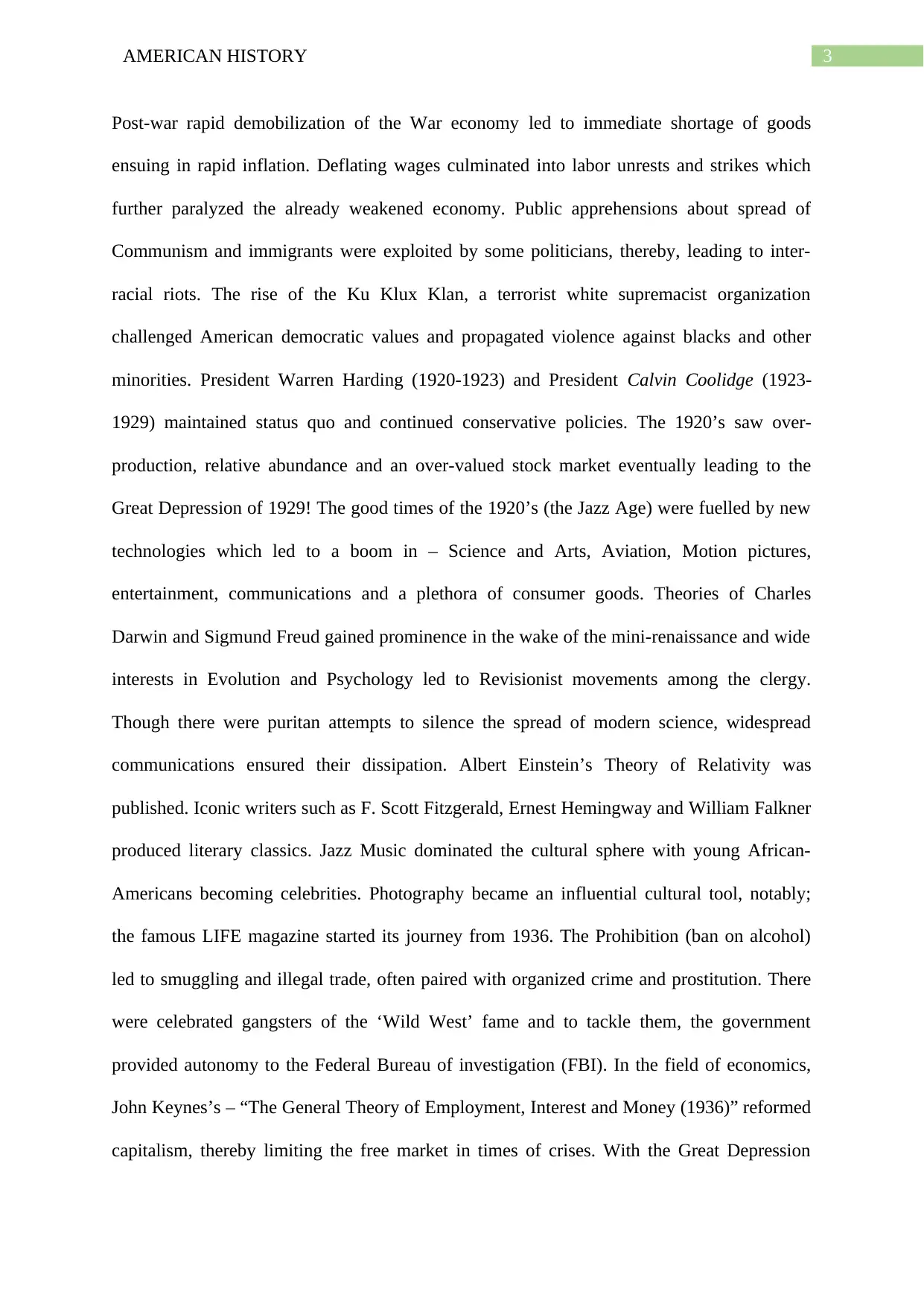
3AMERICAN HISTORY
Post-war rapid demobilization of the War economy led to immediate shortage of goods
ensuing in rapid inflation. Deflating wages culminated into labor unrests and strikes which
further paralyzed the already weakened economy. Public apprehensions about spread of
Communism and immigrants were exploited by some politicians, thereby, leading to inter-
racial riots. The rise of the Ku Klux Klan, a terrorist white supremacist organization
challenged American democratic values and propagated violence against blacks and other
minorities. President Warren Harding (1920-1923) and President Calvin Coolidge (1923-
1929) maintained status quo and continued conservative policies. The 1920’s saw over-
production, relative abundance and an over-valued stock market eventually leading to the
Great Depression of 1929! The good times of the 1920’s (the Jazz Age) were fuelled by new
technologies which led to a boom in – Science and Arts, Aviation, Motion pictures,
entertainment, communications and a plethora of consumer goods. Theories of Charles
Darwin and Sigmund Freud gained prominence in the wake of the mini-renaissance and wide
interests in Evolution and Psychology led to Revisionist movements among the clergy.
Though there were puritan attempts to silence the spread of modern science, widespread
communications ensured their dissipation. Albert Einstein’s Theory of Relativity was
published. Iconic writers such as F. Scott Fitzgerald, Ernest Hemingway and William Falkner
produced literary classics. Jazz Music dominated the cultural sphere with young African-
Americans becoming celebrities. Photography became an influential cultural tool, notably;
the famous LIFE magazine started its journey from 1936. The Prohibition (ban on alcohol)
led to smuggling and illegal trade, often paired with organized crime and prostitution. There
were celebrated gangsters of the ‘Wild West’ fame and to tackle them, the government
provided autonomy to the Federal Bureau of investigation (FBI). In the field of economics,
John Keynes’s – “The General Theory of Employment, Interest and Money (1936)” reformed
capitalism, thereby limiting the free market in times of crises. With the Great Depression
Post-war rapid demobilization of the War economy led to immediate shortage of goods
ensuing in rapid inflation. Deflating wages culminated into labor unrests and strikes which
further paralyzed the already weakened economy. Public apprehensions about spread of
Communism and immigrants were exploited by some politicians, thereby, leading to inter-
racial riots. The rise of the Ku Klux Klan, a terrorist white supremacist organization
challenged American democratic values and propagated violence against blacks and other
minorities. President Warren Harding (1920-1923) and President Calvin Coolidge (1923-
1929) maintained status quo and continued conservative policies. The 1920’s saw over-
production, relative abundance and an over-valued stock market eventually leading to the
Great Depression of 1929! The good times of the 1920’s (the Jazz Age) were fuelled by new
technologies which led to a boom in – Science and Arts, Aviation, Motion pictures,
entertainment, communications and a plethora of consumer goods. Theories of Charles
Darwin and Sigmund Freud gained prominence in the wake of the mini-renaissance and wide
interests in Evolution and Psychology led to Revisionist movements among the clergy.
Though there were puritan attempts to silence the spread of modern science, widespread
communications ensured their dissipation. Albert Einstein’s Theory of Relativity was
published. Iconic writers such as F. Scott Fitzgerald, Ernest Hemingway and William Falkner
produced literary classics. Jazz Music dominated the cultural sphere with young African-
Americans becoming celebrities. Photography became an influential cultural tool, notably;
the famous LIFE magazine started its journey from 1936. The Prohibition (ban on alcohol)
led to smuggling and illegal trade, often paired with organized crime and prostitution. There
were celebrated gangsters of the ‘Wild West’ fame and to tackle them, the government
provided autonomy to the Federal Bureau of investigation (FBI). In the field of economics,
John Keynes’s – “The General Theory of Employment, Interest and Money (1936)” reformed
capitalism, thereby limiting the free market in times of crises. With the Great Depression
Paraphrase This Document
Need a fresh take? Get an instant paraphrase of this document with our AI Paraphraser
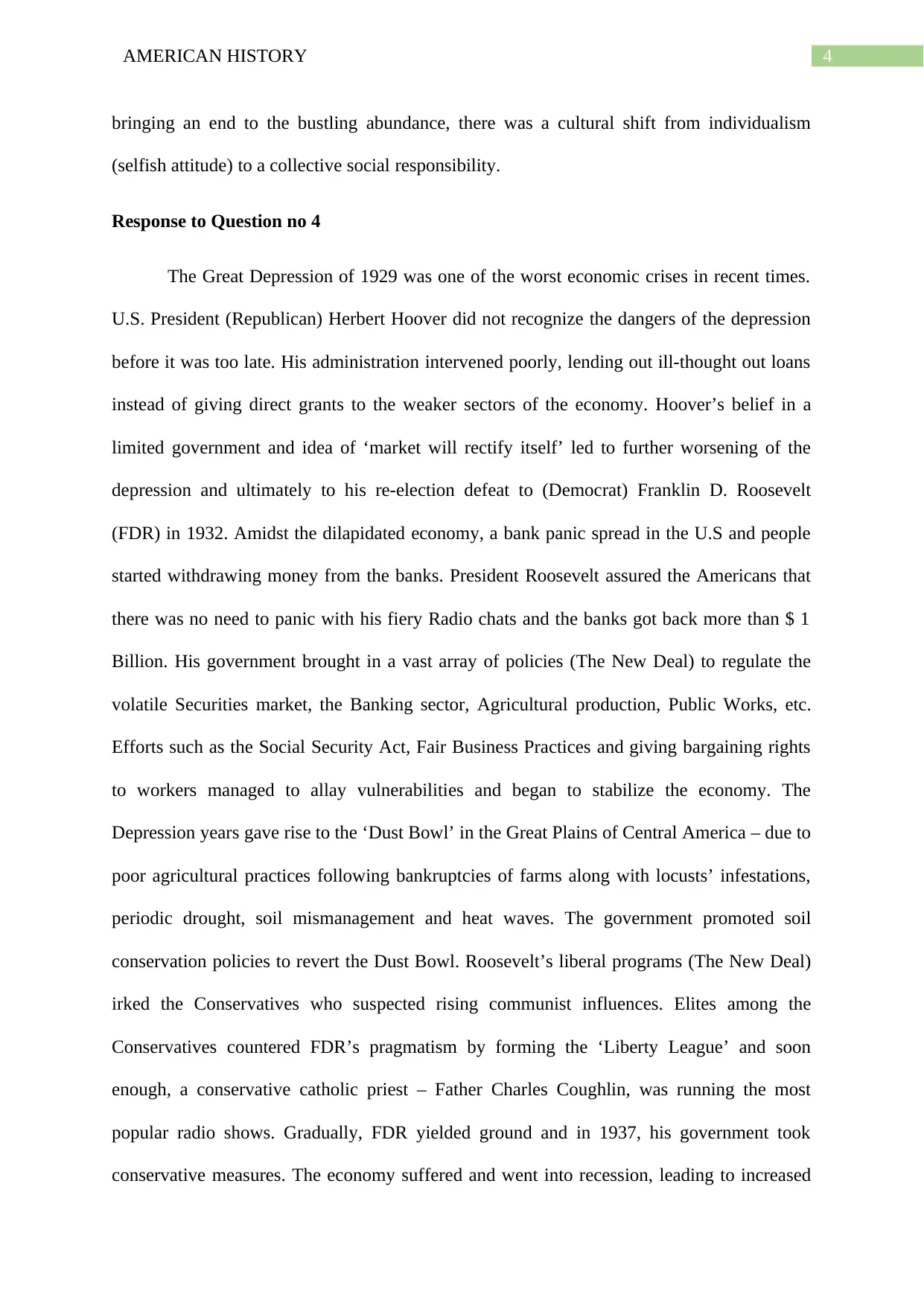
4AMERICAN HISTORY
bringing an end to the bustling abundance, there was a cultural shift from individualism
(selfish attitude) to a collective social responsibility.
Response to Question no 4
The Great Depression of 1929 was one of the worst economic crises in recent times.
U.S. President (Republican) Herbert Hoover did not recognize the dangers of the depression
before it was too late. His administration intervened poorly, lending out ill-thought out loans
instead of giving direct grants to the weaker sectors of the economy. Hoover’s belief in a
limited government and idea of ‘market will rectify itself’ led to further worsening of the
depression and ultimately to his re-election defeat to (Democrat) Franklin D. Roosevelt
(FDR) in 1932. Amidst the dilapidated economy, a bank panic spread in the U.S and people
started withdrawing money from the banks. President Roosevelt assured the Americans that
there was no need to panic with his fiery Radio chats and the banks got back more than $ 1
Billion. His government brought in a vast array of policies (The New Deal) to regulate the
volatile Securities market, the Banking sector, Agricultural production, Public Works, etc.
Efforts such as the Social Security Act, Fair Business Practices and giving bargaining rights
to workers managed to allay vulnerabilities and began to stabilize the economy. The
Depression years gave rise to the ‘Dust Bowl’ in the Great Plains of Central America – due to
poor agricultural practices following bankruptcies of farms along with locusts’ infestations,
periodic drought, soil mismanagement and heat waves. The government promoted soil
conservation policies to revert the Dust Bowl. Roosevelt’s liberal programs (The New Deal)
irked the Conservatives who suspected rising communist influences. Elites among the
Conservatives countered FDR’s pragmatism by forming the ‘Liberty League’ and soon
enough, a conservative catholic priest – Father Charles Coughlin, was running the most
popular radio shows. Gradually, FDR yielded ground and in 1937, his government took
conservative measures. The economy suffered and went into recession, leading to increased
bringing an end to the bustling abundance, there was a cultural shift from individualism
(selfish attitude) to a collective social responsibility.
Response to Question no 4
The Great Depression of 1929 was one of the worst economic crises in recent times.
U.S. President (Republican) Herbert Hoover did not recognize the dangers of the depression
before it was too late. His administration intervened poorly, lending out ill-thought out loans
instead of giving direct grants to the weaker sectors of the economy. Hoover’s belief in a
limited government and idea of ‘market will rectify itself’ led to further worsening of the
depression and ultimately to his re-election defeat to (Democrat) Franklin D. Roosevelt
(FDR) in 1932. Amidst the dilapidated economy, a bank panic spread in the U.S and people
started withdrawing money from the banks. President Roosevelt assured the Americans that
there was no need to panic with his fiery Radio chats and the banks got back more than $ 1
Billion. His government brought in a vast array of policies (The New Deal) to regulate the
volatile Securities market, the Banking sector, Agricultural production, Public Works, etc.
Efforts such as the Social Security Act, Fair Business Practices and giving bargaining rights
to workers managed to allay vulnerabilities and began to stabilize the economy. The
Depression years gave rise to the ‘Dust Bowl’ in the Great Plains of Central America – due to
poor agricultural practices following bankruptcies of farms along with locusts’ infestations,
periodic drought, soil mismanagement and heat waves. The government promoted soil
conservation policies to revert the Dust Bowl. Roosevelt’s liberal programs (The New Deal)
irked the Conservatives who suspected rising communist influences. Elites among the
Conservatives countered FDR’s pragmatism by forming the ‘Liberty League’ and soon
enough, a conservative catholic priest – Father Charles Coughlin, was running the most
popular radio shows. Gradually, FDR yielded ground and in 1937, his government took
conservative measures. The economy suffered and went into recession, leading to increased
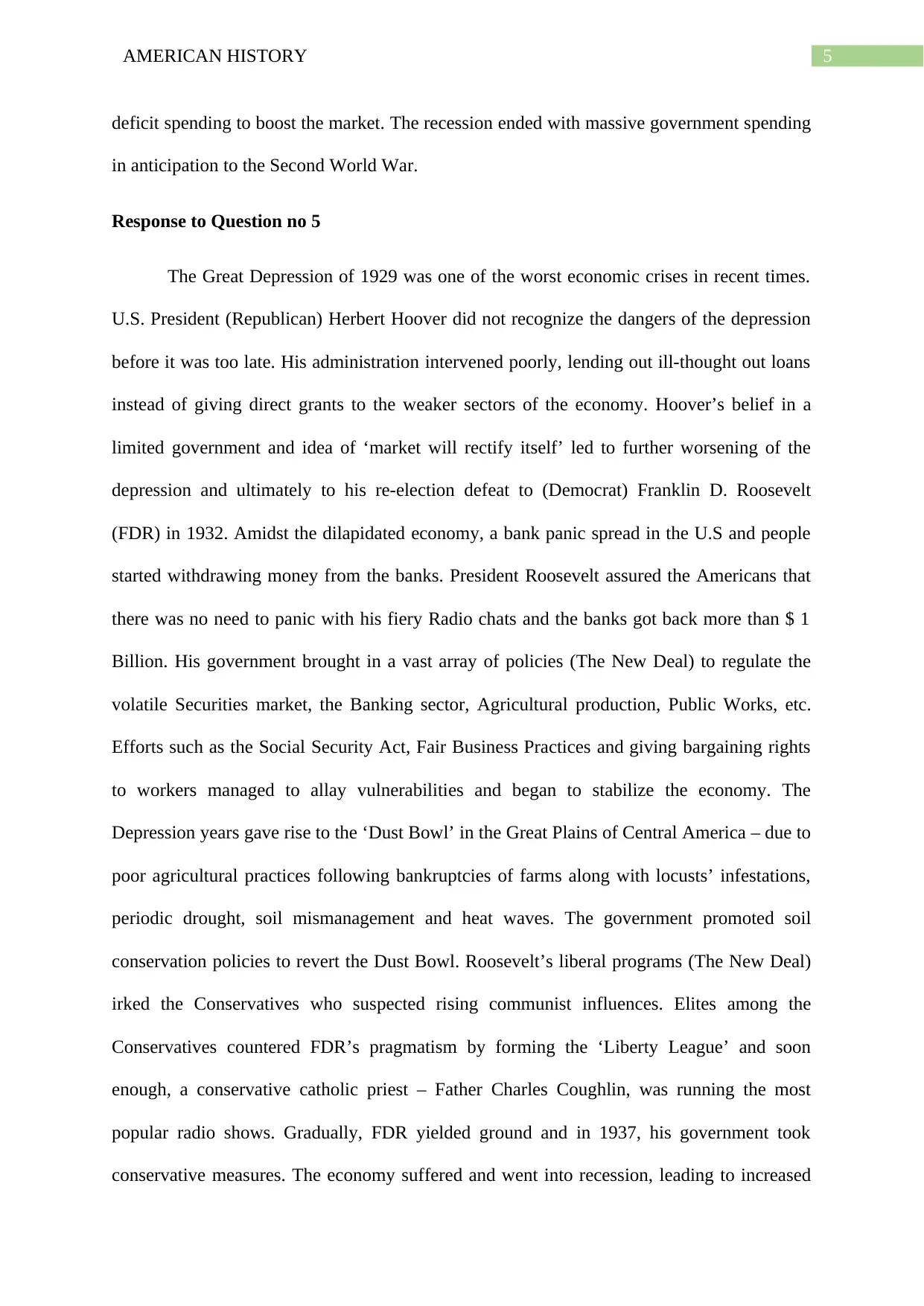
5AMERICAN HISTORY
deficit spending to boost the market. The recession ended with massive government spending
in anticipation to the Second World War.
Response to Question no 5
The Great Depression of 1929 was one of the worst economic crises in recent times.
U.S. President (Republican) Herbert Hoover did not recognize the dangers of the depression
before it was too late. His administration intervened poorly, lending out ill-thought out loans
instead of giving direct grants to the weaker sectors of the economy. Hoover’s belief in a
limited government and idea of ‘market will rectify itself’ led to further worsening of the
depression and ultimately to his re-election defeat to (Democrat) Franklin D. Roosevelt
(FDR) in 1932. Amidst the dilapidated economy, a bank panic spread in the U.S and people
started withdrawing money from the banks. President Roosevelt assured the Americans that
there was no need to panic with his fiery Radio chats and the banks got back more than $ 1
Billion. His government brought in a vast array of policies (The New Deal) to regulate the
volatile Securities market, the Banking sector, Agricultural production, Public Works, etc.
Efforts such as the Social Security Act, Fair Business Practices and giving bargaining rights
to workers managed to allay vulnerabilities and began to stabilize the economy. The
Depression years gave rise to the ‘Dust Bowl’ in the Great Plains of Central America – due to
poor agricultural practices following bankruptcies of farms along with locusts’ infestations,
periodic drought, soil mismanagement and heat waves. The government promoted soil
conservation policies to revert the Dust Bowl. Roosevelt’s liberal programs (The New Deal)
irked the Conservatives who suspected rising communist influences. Elites among the
Conservatives countered FDR’s pragmatism by forming the ‘Liberty League’ and soon
enough, a conservative catholic priest – Father Charles Coughlin, was running the most
popular radio shows. Gradually, FDR yielded ground and in 1937, his government took
conservative measures. The economy suffered and went into recession, leading to increased
deficit spending to boost the market. The recession ended with massive government spending
in anticipation to the Second World War.
Response to Question no 5
The Great Depression of 1929 was one of the worst economic crises in recent times.
U.S. President (Republican) Herbert Hoover did not recognize the dangers of the depression
before it was too late. His administration intervened poorly, lending out ill-thought out loans
instead of giving direct grants to the weaker sectors of the economy. Hoover’s belief in a
limited government and idea of ‘market will rectify itself’ led to further worsening of the
depression and ultimately to his re-election defeat to (Democrat) Franklin D. Roosevelt
(FDR) in 1932. Amidst the dilapidated economy, a bank panic spread in the U.S and people
started withdrawing money from the banks. President Roosevelt assured the Americans that
there was no need to panic with his fiery Radio chats and the banks got back more than $ 1
Billion. His government brought in a vast array of policies (The New Deal) to regulate the
volatile Securities market, the Banking sector, Agricultural production, Public Works, etc.
Efforts such as the Social Security Act, Fair Business Practices and giving bargaining rights
to workers managed to allay vulnerabilities and began to stabilize the economy. The
Depression years gave rise to the ‘Dust Bowl’ in the Great Plains of Central America – due to
poor agricultural practices following bankruptcies of farms along with locusts’ infestations,
periodic drought, soil mismanagement and heat waves. The government promoted soil
conservation policies to revert the Dust Bowl. Roosevelt’s liberal programs (The New Deal)
irked the Conservatives who suspected rising communist influences. Elites among the
Conservatives countered FDR’s pragmatism by forming the ‘Liberty League’ and soon
enough, a conservative catholic priest – Father Charles Coughlin, was running the most
popular radio shows. Gradually, FDR yielded ground and in 1937, his government took
conservative measures. The economy suffered and went into recession, leading to increased
⊘ This is a preview!⊘
Do you want full access?
Subscribe today to unlock all pages.

Trusted by 1+ million students worldwide
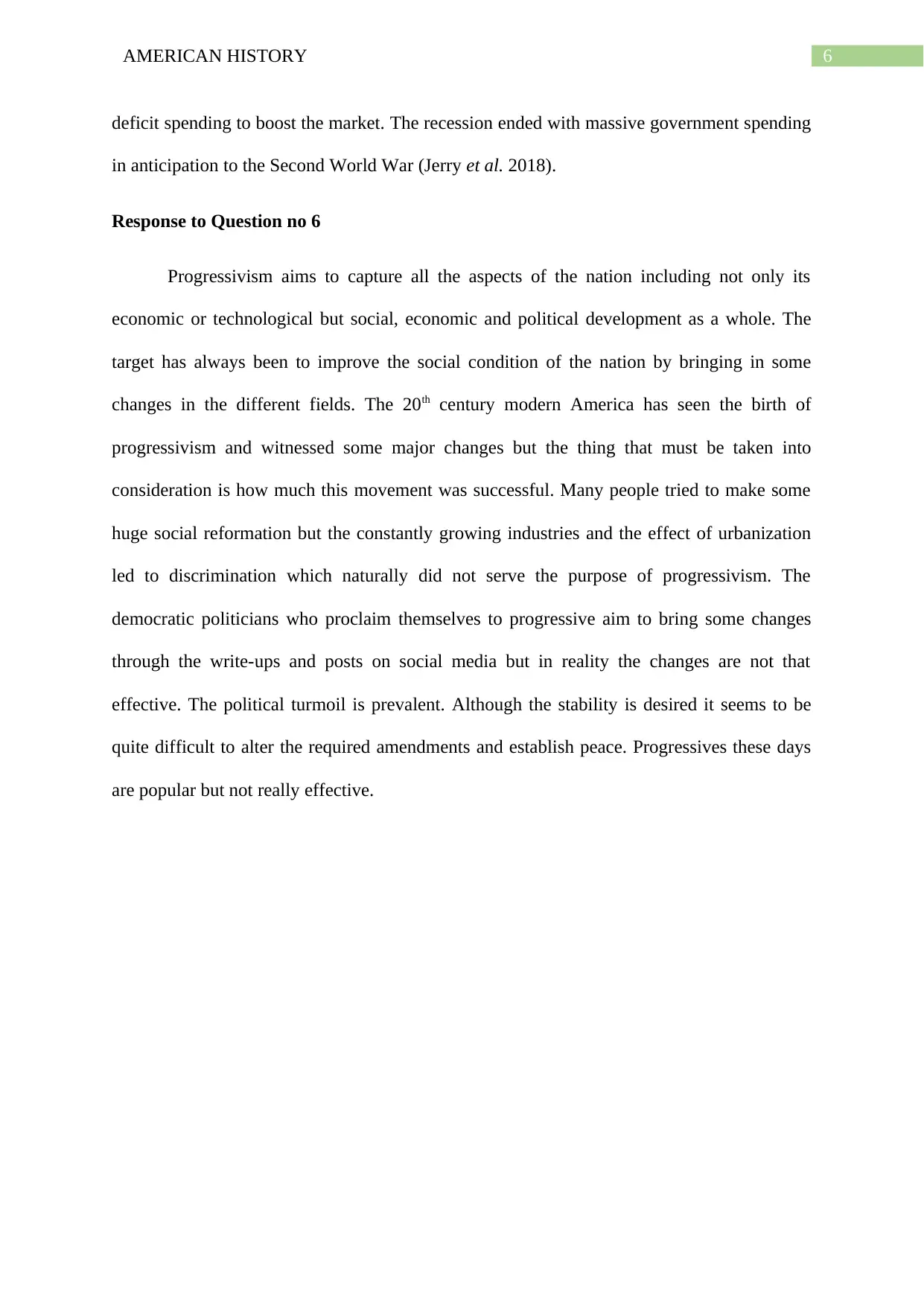
6AMERICAN HISTORY
deficit spending to boost the market. The recession ended with massive government spending
in anticipation to the Second World War (Jerry et al. 2018).
Response to Question no 6
Progressivism aims to capture all the aspects of the nation including not only its
economic or technological but social, economic and political development as a whole. The
target has always been to improve the social condition of the nation by bringing in some
changes in the different fields. The 20th century modern America has seen the birth of
progressivism and witnessed some major changes but the thing that must be taken into
consideration is how much this movement was successful. Many people tried to make some
huge social reformation but the constantly growing industries and the effect of urbanization
led to discrimination which naturally did not serve the purpose of progressivism. The
democratic politicians who proclaim themselves to progressive aim to bring some changes
through the write-ups and posts on social media but in reality the changes are not that
effective. The political turmoil is prevalent. Although the stability is desired it seems to be
quite difficult to alter the required amendments and establish peace. Progressives these days
are popular but not really effective.
deficit spending to boost the market. The recession ended with massive government spending
in anticipation to the Second World War (Jerry et al. 2018).
Response to Question no 6
Progressivism aims to capture all the aspects of the nation including not only its
economic or technological but social, economic and political development as a whole. The
target has always been to improve the social condition of the nation by bringing in some
changes in the different fields. The 20th century modern America has seen the birth of
progressivism and witnessed some major changes but the thing that must be taken into
consideration is how much this movement was successful. Many people tried to make some
huge social reformation but the constantly growing industries and the effect of urbanization
led to discrimination which naturally did not serve the purpose of progressivism. The
democratic politicians who proclaim themselves to progressive aim to bring some changes
through the write-ups and posts on social media but in reality the changes are not that
effective. The political turmoil is prevalent. Although the stability is desired it seems to be
quite difficult to alter the required amendments and establish peace. Progressives these days
are popular but not really effective.
Paraphrase This Document
Need a fresh take? Get an instant paraphrase of this document with our AI Paraphraser
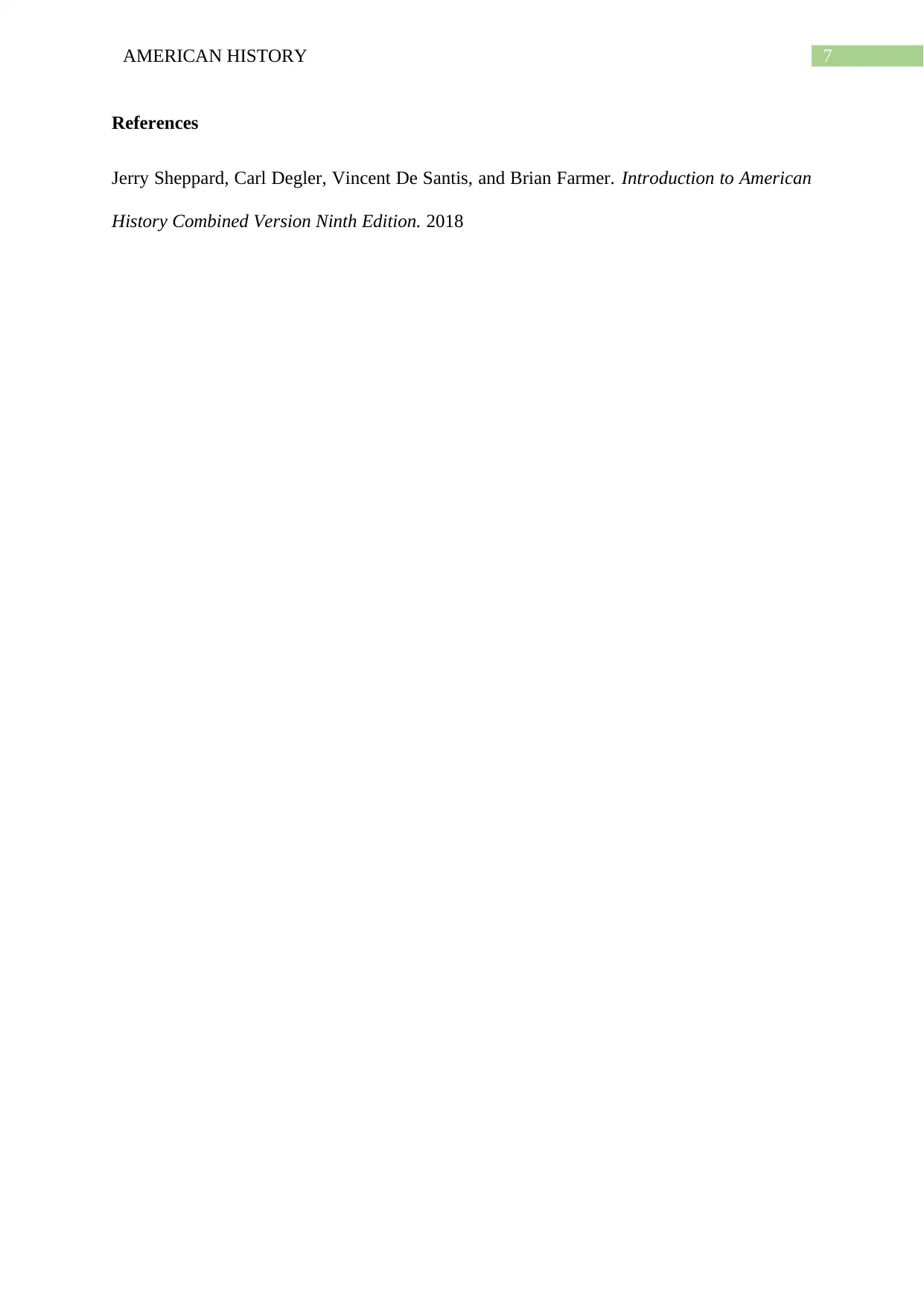
7AMERICAN HISTORY
References
Jerry Sheppard, Carl Degler, Vincent De Santis, and Brian Farmer. Introduction to American
History Combined Version Ninth Edition. 2018
References
Jerry Sheppard, Carl Degler, Vincent De Santis, and Brian Farmer. Introduction to American
History Combined Version Ninth Edition. 2018
1 out of 8
Related Documents
Your All-in-One AI-Powered Toolkit for Academic Success.
+13062052269
info@desklib.com
Available 24*7 on WhatsApp / Email
![[object Object]](/_next/static/media/star-bottom.7253800d.svg)
Unlock your academic potential
Copyright © 2020–2025 A2Z Services. All Rights Reserved. Developed and managed by ZUCOL.





